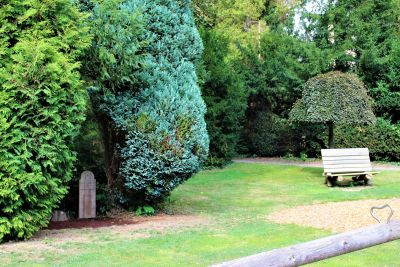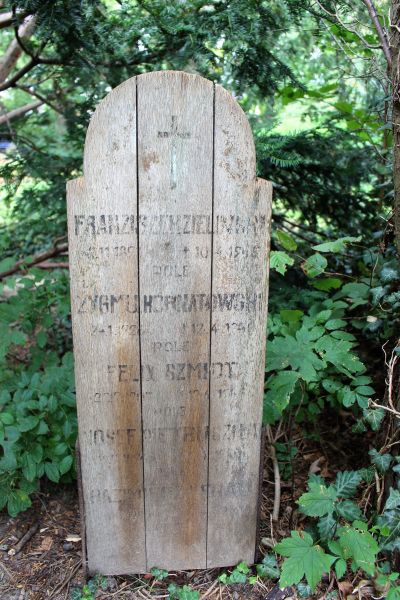The ten forgotten faces in the park
What were seven Polish men and three other men from Italy and the Soviet Union doing in Wetter an der Ruhr in 1945 to lose their lives there?
On 1 September 1939, shortly after the invasion of Poland and the beginning of the Second World War, the German armaments industry was already in need of a large workforce. The locals, who had been sent to the front, were to be replaced by a foreign civilian workforce, recruited with increasing brutality, and by prisoners of war[6]; this was also the case in Wetter. A letter from the Reich Ministry of Labour dated 9 October 1939 informed the town for the first time that it was to use prisoners of war in agriculture and forestry; Ennepe-Ruhr-Kreis was already expecting its first Polish prisoners of war on 13 November 1939 and made rapid preparations to house them and to create sanitary facilities, surveillance, pillows made of straw and the perimeter fencing with barbed wire – there were no iron locks due to the lack of raw materials –, so that “from the outset, there is no possibility of direct interaction with the population”.[7] Three months after the start of the war, a quarter of a million Polish prisoners of war were deployed in the German Reich and around 30,000 Polish civilian workers, predominantly women.[8]
Working prisoners of war in Wetter were initially housed in venues that had been seized (for example “Bauer‘scher Saal Camp”, “Düllmann’scher Saal Camp”), but were later placed in specially erected barrack camps (like those in Oberwengern). Companies like the DEMAG public limited company, the Carl Bönnhoff steel foundry, the Ludwig Bönnhoff steel foundry, the Mark A.G. steel foundry, the Carl und Walter Prinz drop forge and file factory, the Harkort-Eicken Hagen steel foundry headquartered in Wetter, the Geis construction company and the town of Wetter itself requisitioned prisoners of war, as did Lindackers dye works and chemical cleaning company. The companies and the town contributed to the costs of the camp, and small businesses from Wetter issued invoices for food, washing services, office supplies (camp stamp), blackout papers, medication and more.[9]
It is against this background that those ten men also arrived in the Ruhr area. The seven men from Poland were accommodated in a camp (house) in Kaiserstraße 56. According to Hagen address books, ten years previously this accommodation had housed a Catholic citizens’ association and club house, a castellan and a milliner, and must not have been far from the Catholic parish church of St. Peter and Paul. The innkeeper Wilhelm Dröge was registered at this address from 1938 to the 1950s, with a “waitress” being added in 1941/42.[10] The other three men were assigned to other sites: The Ukrainian to the Düllmann‘scher Saal camp in Schöntaler Straße 40, the Russian from Stalingrad to the camp belonging to the Bönnhoff companies in Wittener Straße 2 and the Italian doctor to the large DEMAG camp in Oberwengern.[11]
In the last days of the war, the industrial town of Wetter was subjected to heavy artillery fire by the Americans. As well as private residences and the hospital, the camps housing prisoners of war and forced labourers were also hit. Five of the Poles listed on the wooden headstone died at midnight on 12 April 1945 when Kaiserstraße 56 came under fire, two other Poles who were also registered there were killed in other violent circumstances – the 54-year-old two days prior and the 32-year-old three days later. The Italian doctor from the Oberwengern camp was also killed late in the evening of 12 April 1945 by shrapnel when he was providing assistance in the Düllmann’scher Saal camp. The 27-year-old Ukrainian died before daybreak on 16 April 1945, three days after the surrender of Wetter, from serious gunshot wounds which he had received “for looting”.[12] The food shortage and consequently the severe hunger in Wetter has been described a number of times by the war chroniclers of the time; there was also a curfew from 6.00 p.m. to 8.00 a.m. According to the appeal made by the interim Mayor Lorek on 14 April 1945, the people of Wetter were also responsible for catering for the “the foreign workers”.[13] The Russian camp warden in the Wittener Straße 2 camp also only survived the town’s defeat by a few hours: According to his death certificate, his fellow countrymen wreaked a bloody revenge on him.[14]
They must have been chaotic, hectic days in Wetter: On 13 April 1945, it was surrendered to representatives of the American troops. The camps for prisoners of war and forced labourers were disbanded and all those who had been kept in subjugation freed themselves and demanded bread and rights. The losers were worried and hurriedly destroyed incriminating documents.
The town of Wetter buried many of those forced labourers killed in the new cemetery (today: Park der Ruhe, Gartenstraße) and the Evangelical Cemetery in (Wetter-) Wengern. The seven Poles from the wooden headstones who had lost their lives in the last days of the war found their final resting place with the Italian, the Ukrainian and the Russian two streets away in the old Wetter cemetery. On 14 June 1945, Mayor Lorek revoked the ‘out of use’ order of 2 August 1941 and decided to allow the site in Bornstraße to be used for burials again.[15] This means that the collective grave of the ten dead men was erected two months at the earliest after the deadly events in April. (Fig. 4)
[6] They were required to work under the Geneva Convention of 1929 and could be requisitioned through local employment offices.
[7] See Wetter/Ruhr municipal archive.
[8] Mentner, Regina: Die Beschäftigung von Zwangsarbeiterinnen und Zwangsarbeitern für Aufgaben des “alten” Ennepe-Ruhr-Kreises, Schwelm 2002, p. 6; https://www.enkreis.de/fileadmin/user_upload/Dokumente/01/dokumentation… (last accessed on 11/10/2021.)
[9] See correspondence between Lindackers and the town of Wetter/Ruhr, 9/9/1940; Agreement between the companies and Mr Walter Düllmann (Camp) 22/5/1941, 4/2/1943; invoices paid to the Düllmann prisoner of war camp in the period from 1/1 to 17/3/1943; Wetter/Ruhr municipal archive.
[10] Address books from the town of Hagen with entries from the town of Wetter from 1934, 1938, 1941/42, 1951; Wetter/Ruhr municipal archive. See also local reference to the Dröge restaurant in: Thier, Dietrich (Publ.): Die Kriegschronik der Stadt Wetter (Ruhr) von Gustav Ebert. Veröffentlichungen des Stadtarchivs Wetter (Ruhr) (Vol. 2), Wetter (Ruhr) 2000, p. 249.
[11] There are said to have been 1210 prisoners of war and forced labourers in the Oberwengern camp; there were Italian prisoners of war, “Eastern and Western workers” (forced labourers) and families with infants and children; see: Thier, Dietrich: Kriegsgefangenen- und Fremdarbeiterlager in Wetter (Ruhr) zwischen 1939 und 1945, in: Kniehase, Hans-Friedrich / Thier, Dietrich (Publ.): PROJEKTE. Landeskundliche Studien im Bereich des mittleren Ruhrtales. Schriftenreihe der Friedrich-Harkort-Gesellschaft Wetter (Ruhr) und des Stadtarchivs Wetter (Ruhr), Wetter (Ruhr) 1996, p. 225–229.
[12] Death certificates, Ruhr municipal archive. The 32-year-old had been shot from behind two days after the town had surrendered. According to Thier (1996), “heart failure” always indicates an “unnatural death”, see p. 71, 229, 231. Inhabitants of Wetter remembered the last days of the war in the Westfalenpost, for example 11/4/2021, 23/4/2021.
[13] Regarding hunger in the town, see also: Die Kriegschronik der Stadt Wetter (Ruhr)(2000), passim, also p. 209f.; der Aufruf ibid., p. 202.
[14] The town’s list of graves presumably contains a transcription error (typing error).
[15] Revoking of the ‘out of use’ order of the old cemetery (Bornstraße), see war chronicle of Wetter (Ruhr). Upon enquiry, the Volksbund Deutsche Kriegsgräberfürsorge (Münster) is not aware of any memorial which is directly next to and not zoned off from various play equipment. Only in Ysselsteyn (NL) is there a youth centre close to the war graves site which is, however, separated by a fence and a row of trees. Under the Graves Act, victims of war and tyranny have an unrestricted right to a resting place. The playground was opened again on 10 June 2019 after renovation work without taking the war graves site into consideration; cf. https://www.wetter-ruhr.info/2019/07/spielplatz-alter-friedhof-wird-am-… (last accessed on 11/10/2021).






